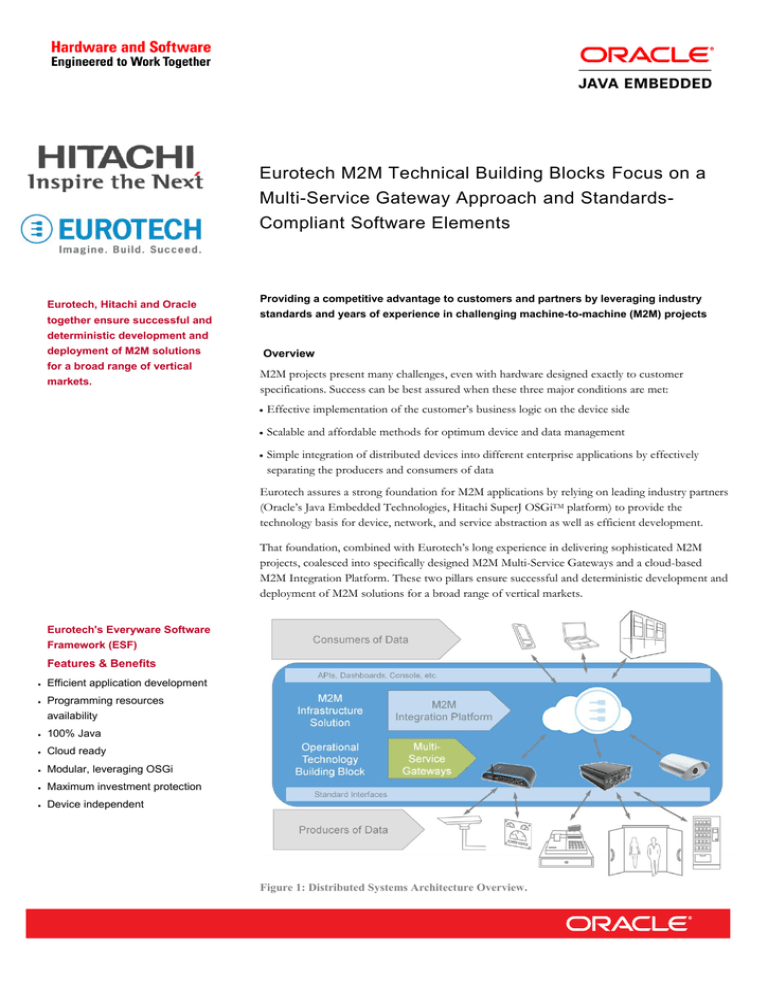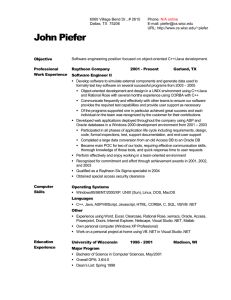
Eurotech M2M Technical Building Blocks Focus on a
Multi-Service Gateway Approach and StandardsCompliant Software Elements
Eurotech, Hitachi and Oracle
together ensure successful and
Providing a competitive advantage to customers and partners by leveraging industry
standards and years of experience in challenging machine-to-machine (M2M) projects
deterministic development and
deployment of M2M solutions
for a broad range of vertical
markets.
Overview
M2M projects present many challenges, even with hardware designed exactly to customer
specifications. Success can be best assured when these three major conditions are met:
Effective implementation of the customer’s business logic on the device side
Scalable and affordable methods for optimum device and data management
Simple integration of distributed devices into different enterprise applications by effectively
separating the producers and consumers of data
Eurotech assures a strong foundation for M2M applications by relying on leading industry partners
(Oracle’s Java Embedded Technologies, Hitachi SuperJ OSGiTM platform) to provide the
technology basis for device, network, and service abstraction as well as efficient development.
That foundation, combined with Eurotech’s long experience in delivering sophisticated M2M
projects, coalesced into specifically designed M2M Multi-Service Gateways and a cloud-based
M2M Integration Platform. These two pillars ensure successful and deterministic development and
deployment of M2M solutions for a broad range of vertical markets.
Eurotech's Everyware Software
Framework (ESF)
Features & Benefits
Efficient application development
Programming resources
availability
100% Java
Cloud ready
Modular, leveraging OSGi
Maximum investment protection
Device independent
Figure 1: Distributed Systems Architecture Overview.
Eurotech M2M Technical Building Blocks Focus on a Multi-Service Gateway Approach and
Standards-Compliant Software Elements
This approach provides
Eurotech’s partners with a
competitive advantage by
ensuring a dramatic reduction
of time, cost and risk in M2M
projects:
Helping Customers and Partners Focus on Their Core Competencies
Connected devices and M2M solutions enable companies to provide higher value through
services, improving efficiency through data collection and 2-way customer feedback by utilizing
connected devices. Regardless of whether they are end users or system integrators, it is all about
providing enabling platforms, not just components!
Shorter time-to-market
The Multi-Service Gateway Approach
More deterministic development
Lower barrier to entry
Minimizes customer development risk by utilizing “off the shelf” purpose-built devices
designed to meet vertical market value propositions
Future-proof applications
Provides design flexibility by leveraging the Multi-Service Gateway approach to integrate and
consolidate data streams and future-proof investments
Reduces design complexity while introducing the Application Lifecycle Management approach
The benefits of IT-centric application development using ESF to implement business logic in
smart edge devices / service gateways are:
-
Simplifying application development for smart M2M Multi-Service Gateways with
Everyware Software Framework (ESF), a Java/OSGi based application framework
field update and refresh enables
-
Optimizing portability across systems and hardware architectures
ability to add new features for
-
Improving device management
-
Native M2M platform integration (Everyware Cloud, MQTT)
-
Application management
Grow ROI
Extend Product Lifecycle – In-
improved customer value
Competitive Advantage –
Standards-based systems allow
focus on business value, reuse
commodities from an existing
ecosystem.
Innovation – Fueled by largest
pool of developer talent, millions
of engineering students are
experienced in Java
development.
Increase Market Reach –
Partner in the world’s largest
developer ecosystem.
Figure 2: Software portability ensures efficient development and investment protection
across hardware platforms.
Oracle’s Java Technologies
Java provides the widest cross platform capability from the smallest microcontroller devices to
high performing enterprise systems. By building your project strategy around Java you can tap
into the existing 9 million developers currently building exciting applications.
Copyright © 2013, Oracle and/or its affiliates. All rights reserved. Oracle and Java are registered trademarks of Oracle and/or its affiliates. Other names may be trademarks of their respective owners. Intel and
Intel Xeon are trademarks or registered trademarks of Intel Corporation. All SPARC trademarks are used under license and are trademarks or registered trademarks of SPARC International, Inc. AMD, Opteron,
the AMD logo, and the AMD Opteron logo are trademarks or registered trademarks of Advanced Micro Devices. UNIX is a registered trademark of The Open Group. 0113
OSGi is a trademark or a registered trademark of the OSGi Alliance in the United States, other countries, or both. SuperJ is a registered trademark of Hitachi Solutions, Ltd.
Eurotech M2M Technical Building Blocks Focus on a Multi-Service Gateway Approach and
Standards-Compliant Software Elements
Reduce Cost
Oracle Java Embedded is ideal for application code development in any connected device,
enabling a robust software infrastructure for service delivery platforms. Portability across
devices is achieved through using a common set of Java APIs on multiple devices. This
enables easy code development through software simulation before porting onto your
embedded product and reducing time to market.
Oracle Java SE Embedded is targeted at gateway devices, which typically use a Linux
operating system, with various CPU versions available, including ARM and x86 instruction
sets. The performance of the Java VM can improve the increasing number of multi-core
systems through its thread aware application model.
Portability – Increase flexibility
and roadmap planning by
maximizing cross platform
support through compliant
standards, JCP (Java
Community Process) and OSGi
(Open Service Gateway
Initiative)
Shorter Time to Market –
Reduce QA cycles and remove
reinvention. Cost sharing
business model supported by
conformance testing (TCK).
Reduce Cost of Support –
Through remote updates and
device management
Reduce Risk – Most widely
deployed secure, reliable
development platform
Hitachi SuperJ Applications Ecosystem for the OSGi Service Platform
Hitachi’s SuperJ Applications Ecosystem is a framework for the OSGi (Open Services Gateway
Initiative) Service Platform. SuperJ facilitates the modularization of software components and
applications and assures interoperability of applications and services over a variety of M2M
devices.
Hitachi SuperJ is a fully-featured framework that enables the deployment of OSGi technology
plus enhanced functionality on any Java enabled device or gateway. Benefits include:
Modularity, through the separation of application logic/processes into modules
The ability to deploy multiple versions of a module concurrently on a Multi-Service Gateway
The ability to dynamically discover and use “services” provided by other modules in the
system
The ability to dynamically install, uninstall, start, stop and upgrade modules running on a
Multi-Service Gateway
The capability to abstract physical networking interfaces to complex software development by
decoupling the network connection software from the application software
Standards Based – Java VM
developed as an open standard
and backed by Oracle. OSGI
Framework developed by
Hitachi backed by Oracle and
Hitachi as part of the OSGI
Alliance
Figure 3: Software components using Java, OSGi, and ESF.
Copyright © 2013, Oracle and/or its affiliates. All rights reserved. Oracle and Java are registered trademarks of Oracle and/or its affiliates. Other names may be trademarks of their respective owners. Intel and
Intel Xeon are trademarks or registered trademarks of Intel Corporation. All SPARC trademarks are used under license and are trademarks or registered trademarks of SPARC International, Inc. AMD, Opteron,
the AMD logo, and the AMD Opteron logo are trademarks or registered trademarks of Advanced Micro Devices. UNIX is a registered trademark of The Open Group. 0113
OSGi is a trademark or a registered trademark of the OSGi Alliance in the United States, other countries, or both. SuperJ is a registered trademark of Hitachi Solutions, Ltd.
Eurotech M2M Technical Building Blocks Focus on a Multi-Service Gateway Approach and
Standards-Compliant Software Elements
ESF Software Modules
Foundation Layer turns the
device into an internetworking
device and an application
gateway
GUI for device management
from any web browser
Everyware Cloud Client,
MQTT Client
New and legacy protocol
implementations for field
busses, sensors, intelligent
devices and communication
options
Figure 4: ESF Implementation Example.
ESF Features & Benefits Overview
Field Data Capture – Features proven protocol components for data acquisition from infield devices (ModBus, Jbus, PLCs, …)
Application Development – Quickly develop hardware-abstracted and flexible embedded
applications
Programming Resources Availability – Tap into the exisitng community of 9 million Java
developers by creating Java applications implementing customer’s business logic simulated on
PCs and deployed on devices in the field
100% Java – Gain widest cross platform support through compliant Java-based abstraction
APIs over I/O, network, serial, GPS, Bluetooth and other hardware components
Cloud Ready – Built-in client for cloud-based M2M Integration Platform offering advanced
data and device management services, simplifying the interaction with enterprise applications
Modular – Oracle Java and Hitachi SuperJ Applications Ecosystem supports efficient M2M
applications development, and dynamically adding, removing and changing of software
modules (services).
Tools – Advanced development tools based on the industry standard Eclipse platform
Device Independent – ESF runs across device platforms resulting in portable applications
and easy to re-use code
Conclusion
Together, Eurotech, Hitachi and Oracle ensure successful and deterministic development and
deployment of M2M solutions for a broad range of vertical markets. By providing an enabling
platform, ESF - a Java and OSGi based application framework, allows customers and partners
to focus on their core competencies and provide higher value through services, improve
efficiency, and reduce costs by utilizing connected devices.
CONTACT US
To learn more about Oracle’s Java Embedded Technologies see www.oracle.com/goto/javaembedded. To learn more about Hitachi SuperJ
Applications Ecosystem for the OSGi Service Platform see www.hitachi-cta.com/solutions/applications/m2mapps.html. To learn more about
Eurotech see www.eurotech.com/esf.
Copyright © 2013, Oracle and/or its affiliates. All rights reserved. Oracle and Java are registered trademarks of Oracle and/or its affiliates. Other names may be trademarks of their respective owners. Intel and
Intel Xeon are trademarks or registered trademarks of Intel Corporation. All SPARC trademarks are used under license and are trademarks or registered trademarks of SPARC International, Inc. AMD, Opteron,
the AMD logo, and the AMD Opteron logo are trademarks or registered trademarks of Advanced Micro Devices. UNIX is a registered trademark of The Open Group. 0113
OSGi is a trademark or a registered trademark of the OSGi Alliance in the United States, other countries, or both. SuperJ is a registered trademark of Hitachi Solutions, Ltd.

